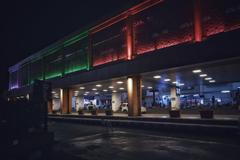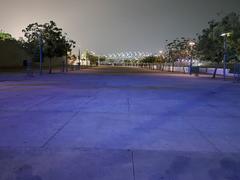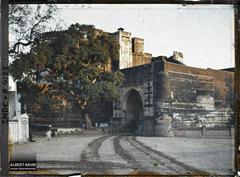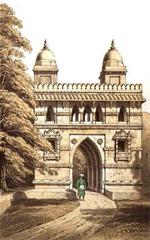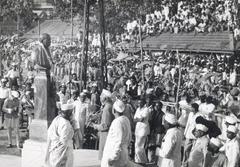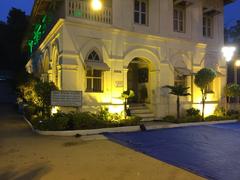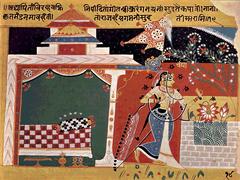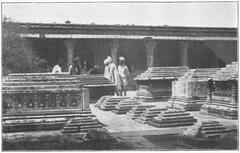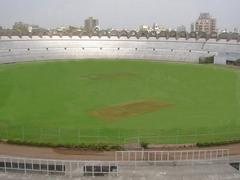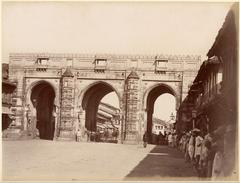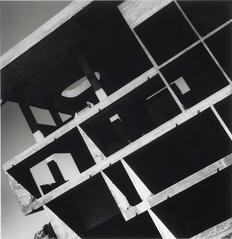Delhi Darwaja Ahmedabad: Visiting Hours, Tickets, and Historical Sites Guide
Date: 03/07/2025
Introduction
Delhi Darwaja—also known as Delhi Gate or Idariyo Darwajo—is one of Ahmedabad’s most iconic and historically significant gateways. Standing on the northern edge of the old walled city, it embodies an impressive Indo-Islamic architectural legacy and has played a central role in the city’s defense, trade, and cultural life since its construction in the 15th century. Initially built under Sultan Mahmud Begada, Delhi Darwaja was conceived as the city’s main northern entrance, directly linking Ahmedabad to the imperial road leading to Delhi. Today, it remains a bustling urban landmark, surrounded by vibrant markets and serving as a gathering point for major city festivals and processions (UNESCO Urban Heritage Atlas; Heritage of Ahmedabad).
This comprehensive guide details Delhi Darwaja’s origins, architectural features, cultural importance, practical visiting information—including hours, tickets, accessibility—and tips for making the most of your visit to this essential Ahmedabad historical site.
Table of Contents
- Origins and Foundation of Delhi Darwaja
- Architectural Features and Construction
- Role in Urban Planning and Defense
- Cultural and Social Significance
- Visiting Delhi Darwaja: Hours, Tickets, Accessibility
- Travel Tips and Local Experiences
- Nearby Attractions
- Frequently Asked Questions (FAQ)
- Preservation and Modern Context
- Conclusion and Visit Summary
- Related Articles and Resources
- References
Origins and Foundation of Delhi Darwaja
Delhi Darwaja’s roots trace back to the early expansion of Ahmedabad during the Gujarat Sultanate. Founded in 1411 CE by Sultan Ahmed Shah I, the city was originally protected by Bhadra Fort and eight gates. As the city grew, new fortifications and gates were added; Delhi Darwaja was constructed under Sultan Mahmud Begada (ruled 1458–1511), Ahmed Shah’s grandson, to serve as the fortified northern entrance (Heritage of Ahmedabad; Wikipedia: Gates of Ahmedabad).
Its alternate name, Idariyo Darwajo, commemorates Mahmud Begada’s campaign against the Idar State. From its inception, Delhi Darwaja was a key node in the city’s defense and a critical link to northern India, reflecting both military strategy and urban planning (Ahmedabad City Heritage).
Architectural Features and Construction
Delhi Darwaja is a prime example of late medieval Indo-Islamic military architecture. The gateway is built of robust ashlar masonry and brick, bound with lime mortar for durability. Its most distinctive feature is the triple-arched passage: a wide central arch for elephants and processions, with two smaller side arches for pedestrian and lighter traffic (Islamic Architectural Heritage; Gujarat Tourism).
Flanked by semi-circular bastions and capped with crenellated parapets, the gate was designed for both defense and grandeur. Internal staircases lead to upper guard chambers, and the original wooden doors were reinforced with iron spikes to withstand attacks—including those by war elephants. Ornamental details include geometric patterns, floral motifs, and animal carvings, blending Persian, Mughal, and Gujarati design elements.
British authorities modified the gate in the late 19th century, adding pedestrian openings and making alterations for urban traffic (Ahmedabad City Heritage).
Role in Urban Planning and Defense
Delhi Darwaja’s position reflected its role as the main northern gateway, directly connecting Ahmedabad with Delhi’s imperial road. It formed part of a larger defensive network, with up to 21 city gates regulating entry, trade, and taxation, and separating city quarters or “puras” (later “pols”) (Heritage of Ahmedabad). The gate served as a checkpoint for goods and travelers, reinforcing Ahmedabad’s status as a commercial and strategic hub.
Cultural and Social Significance
Delhi Darwaja remains an epicenter of community life in Ahmedabad. The surrounding markets are especially vibrant during festivals like Diwali, Uttrayan (kite festival), and Holi, with stalls selling seasonal goods, textiles, jewelry, and local snacks (Ahmedabad City Heritage). The area is also home to historic trading firms and is close to major religious landmarks such as the Hutheesing Jain Temple.
During the annual Jagannath Rath Yatra, one of Ahmedabad’s largest religious processions, thousands of devotees and chariots pass through Delhi Darwaja, highlighting its enduring civic and spiritual significance (Bombay Samachar).
Ahmedabad’s multicultural ethos is reflected in the proximity of mosques, temples, and vibrant markets, making Delhi Darwaja a symbol of the city’s pluralism and resilience (Rough Guides).
Visiting Delhi Darwaja: Hours, Tickets, Accessibility
- Visiting Hours: Delhi Darwaja is open 24/7 as a public city gate. For the best experience and safety, visit between 8:00 AM and 7:00 PM.
- Entry Fee: There is no entry fee; the monument is free to visit.
- Accessibility: The area is pedestrian-friendly but can be crowded and has uneven pavements. Wheelchair access is limited; assistance is recommended for differently-abled visitors.
- Photography: Photography is permitted; ask before photographing people, especially in markets or during festivals.
- Facilities: Public restrooms are scarce; ATMs and banks are available within 1 km. Mobile network coverage is strong.
Travel Tips and Local Experiences
- Getting There: Delhi Darwaja is located near Delhi Chakla, about 4 km from Ahmedabad Railway Station and 10 km from the airport. Auto-rickshaws, taxis, and city buses are the most convenient transportation.
- Best Time to Visit: November to February offers pleasant weather. Avoid peak heat (April–June) and expect crowds during monsoon (July–September) and festivals.
- Dress Code: Modest clothing is recommended, especially near religious sites.
- Shopping & Food: The area is renowned for its bazaars—shop for textiles, jewelry, and local handicrafts. Try street food at Manek Chowk and nearby stalls.
- Safety: Ahmedabad is generally safe, but remain vigilant in busy markets. Carry water and travel insurance, and use mosquito protection during monsoon.
Nearby Attractions
- Bhadra Fort: Historic fort and palace complex, a short walk from Delhi Darwaja.
- Manek Chowk: Famous market and night food street nearby.
- Hutheesing Jain Temple: Noted for its beautiful architecture, within walking distance.
- Jama Masjid: One of India’s most significant mosques, also close by.
Explore these sites for a deeper understanding of Ahmedabad’s heritage (Gujarat Tourism; Rough Guides).
Frequently Asked Questions (FAQ)
Q: What are the visiting hours for Delhi Darwaja?
A: Open 24/7, but best visited between 8:00 AM and 7:00 PM.
Q: Is there an entry fee or ticket required?
A: No, entry is free.
Q: Are guided tours available?
A: Yes, several local operators offer heritage walks including Delhi Darwaja.
Q: Is the site wheelchair accessible?
A: Accessibility is limited due to historic pavements and crowds; assistance is recommended.
Q: What is the best way to reach Delhi Darwaja?
A: Easily reached by auto-rickshaw, taxi, or public bus from central Ahmedabad.
Q: Are there public restrooms?
A: Limited; use facilities at nearby restaurants or shopping complexes.
Preservation and Modern Context
Despite the demolition of much of Ahmedabad’s city walls, Delhi Darwaja has been preserved as a protected monument. Restoration efforts by the Archaeological Survey of India and local heritage groups have focused on conserving its structure and decorative features while accommodating the needs of a modern, bustling city (Ahmedabad City Heritage; Heritage of Ahmedabad).
Conclusion and Visit Summary
Delhi Darwaja is not only a gateway into Ahmedabad’s walled city but also an entrance to its complex history, architectural splendor, and vibrant community life. It stands as a symbol of resilience and adaptability—where medieval traditions and contemporary urban rhythms seamlessly coexist. With open access, no entry fees, and proximity to other major landmarks, Delhi Darwaja is a must-visit for history enthusiasts, culture seekers, and travelers seeking an authentic Ahmedabad experience.
Plan your visit during the cooler months, take advantage of guided walks, and explore the bustling bazaars for a truly immersive journey into Ahmedabad’s past and present.
Related Articles and Resources
References
- UNESCO Urban Heritage Atlas
- Heritage of Ahmedabad
- Wikipedia: Gates of Ahmedabad
- Ahmedabad City Heritage
- Islamic Architectural Heritage
- Gujarat Tourism
- Knocksense
- Bombay Samachar
- Rough Guides
- Travelling Camera
